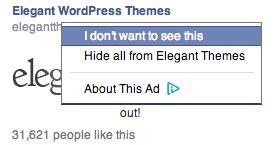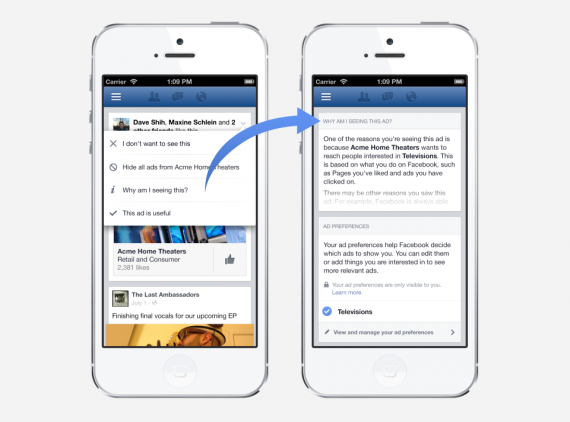In June, Facebook announced the launch of a new feature that allows users to exert more control over the ads they see. Called “ad preferences,” it is a tool accessible for every ad on Facebook — desktop and mobile — that explains why the user is seeing a particular ad and lets them add or remove interests that Facebook uses to show ads.
For example, if a user does not want to see ads about mobile technology, he can remove that category from ad interests.
How Ad Preferences Work
Here is an example of how Facebook ad preferences currently work.
1. Facebook shows me an ad in the right-hand column for Elegant Themes, a WordPress ecommerce theme. (I visited the website earlier in the day, incidentally.)

Facebook shows an ad in the right-hand column for a website recently visited.
2. If I mouse over the ad, an “X” appears in the upper right-hand corner. When clicked, the ad displays the following information:
- I don’t want to see this;
- Hide all from Elegant Themes;
- About this ad.

Ad preference options gives users control over ads that they see.
If I click the first option, I am presented with a list of choices that explain why I don’t want to see the ad. Clicking the second option prevents ads from this advertiser being shown to me again. Clicking “About this ad” takes me to a page that explains the advertiser’s policy regarding why ads are shown.
When ad preferences are fully launched, another option — “Why am I seeing this?” — will display that explains why the ad is being shown to the user.

Another ad preference option explains why the ad was shown.
What This Means for Business
Empowering users to have more control over the ads they see is a good thing, so businesses should not fear that it will negatively impact their reach. Here’s why.
Up to now, businesses could target prospects based on their Facebook activity, such as Pages they like and interests they have expressed. Thanks to remarketing capabilities, Facebook can track users’ activities outside the site and incorporate data about interests based on their web browsing history. This means advertisers have even more data they can use to target ads.
Facebook explained it this way in a blog post announcing the new feature.
“Let’s say that you’re thinking about buying a new TV, and you start researching TVs on the web and in mobile apps. We may show you ads for deals on a TV to help you get the best price or other brands to consider. And because we think you’re interested in electronics, we may show you ads for other electronics in the future, like speakers or a game console to go with your new TV.”
Users who do not want to allow Facebook to have access to browsing history can opt-out of ad targeting. Also, Facebook does not reveal users’ individual identities or data, but aggregates people into groups based on interests.
Relevance Is Key to Conversion
One of the main reasons people do not like seeing ads is because they lack a key factor: relevance. Instead of showing ads that may inspire an adverse reaction, this interest-based advertising has the potential to increase a merchant’s ability to make ads more relevant and hyper-targeted, which can result in higher traffic and conversions.
Ultimately, the new feature should benefit both users and advertisers. It gives users more control over the ads they see and provides advertisers with information about user interests from both inside and outside Facebook, which they can use to create better ads.





